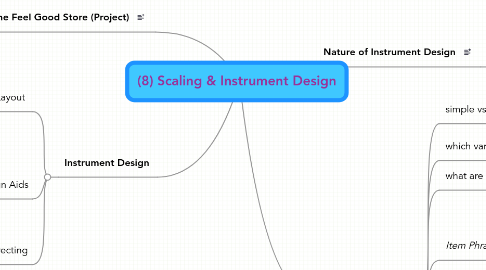
1. Instrument Design
1.1. Scale Sequencing and Layout
1.1.1. start the questionnaire with simple and interesting question
1.1.2. provide clear and easy-to-read instructions if necessary
1.1.3. ask sensitive and classificatory information last
1.1.4. lay out the questionnaire so that it is easy to read and follows the flow of the questionning process
1.2. Online Design Aids
1.2.1. i.e. the Internet
1.2.1.1. Pros:
1.2.1.1.1. helps to structure the questionnaires
1.2.1.1.2. help eliminate bias
1.2.1.1.3. helps with the collection of data
1.2.1.1.4. provide other add-on services
1.3. Pretesting and Correcting
1.3.1. once drafted, the instrument should be pretested
1.3.2. corrections can be made to the instrument from results of the pretest
2. The Feel Good Store (Project)
3. Nature of Instrument Design
3.1. what to include and exclude?
3.1.1. relevance
4. Scale Development
4.1. simple vs complex scales
4.1.1. one-item or multiple-item scales
4.1.2. complex is preferred - enhanced reliability and validity
4.2. which variables should be measured?
4.3. what are the "right" questions to be asked?
4.4. Item Phrasing
4.4.1. is the item necessary?
4.4.1.1. is it needed in the solution of the research problem?
4.4.2. how will the item be asked?
4.4.2.1. interpretation of what is asked is crucial
4.4.3. should the item be open- or closed-ended?
4.4.3.1. open-ended items allow respondants to answer freely
4.4.3.2. closed-ended items limit the answers from respondants
4.4.4. how should the item be worded?
4.4.4.1. keep it simple
4.5. Response Formats
4.5.1. what response alternatives should be used?
4.5.2. in what order should the alternatives be stated?
4.5.3. how will "don't know", "no answer", and "neutral answer" responses be handled?
4.6. Frequently Used Scaling Instruments
4.6.1. rating scales
4.6.1.1. graphic rating scales
4.6.1.1.1. i.e. thermometer chart
4.6.1.2. itemized rating scales
4.6.1.2.1. select a category from a limited amount
4.6.1.3. comparative rating scales
4.6.1.3.1. rate against a standard
4.6.2. attitude scales
4.6.2.1. likert scale
4.6.2.1.1. indicate degree of agreement or disagreement
4.6.2.2. semantic differential
4.6.2.2.1. 5- or 7-point bipolar adjectives
